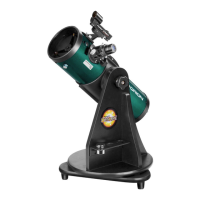14
15
How to Stargaze
How to Stargaze
The Planets do not stay at fixed locations
like the stars do. To find them you can refer
to What’s In The Sky This Month (www.
telescope.com), or charts published monthly
in Astronomy and Sky & Telescope magazines.
Venus, Jupiter, and Saturn are the brightest
objects in the sky after the Sun and the Moon.
The monthly star chart at www.skymaps.com
(see page 10) will show the position of the
planets.
Stars: Even powerful telescopes cannot magnify
a star to appear as more than a point of light.
You can, however, enjoy the different colors
of the stars and locate many pretty double and
multiple stars. Look at the middle star in the
handle of the Big Dipper. It is really two stars
very close together, Mizar and Alcor. Being able
to separate the two stars is called star splitting.
The beautiful two-color double star, Albireo,
in Cygnus, is a favorite and is sometimes
referred to as the Scout Star because it is blue
and gold like the Cub Scouts colors. Defocusing
a star slightly can help bring out its color.
Deep Sky Objects: Under dark skies, you
can see lots of fascinating deep sky objects,
including nebulae, star clusters and a variety
of different types of galaxies.
Most deep sky objects are very faint, so it is
important that you find an observing site well
away from light pollution. Take plenty of time
to let your eyes adjust to the darkness. Do
not expect these objects to appear like the
photographs you see in books and magazines;
many will look like dim gray smudges. As you
become more experienced and your observing
skills increase, you will be able to define more
and more subtle details and structure of these
objects.
Objects to Observe
The Moon is one of the easiest and most
interesting targets to view with your telescope.
Lunar craters, seas, and even mountain ranges
can all be clearly seen from a distance of
238,000 miles!
With its ever-changing phases, you’ll get a
new view of the Moon each night. Make sure
to observe the Moon when it is well above the
horizon to get the sharpest images. The best time
to observe is during a partial phase—that is,
when the Moon is not full.
During partial phases, shadows are cast on the
surface which reveals more detail, especially
right along the border between the dark and
light portions of the disk (called the terminator).
Use the map on the telescope tube to find the
major craters and features.
The Moon map below is oriented as you would
see it in the eyepiece…upside down and flipped.

